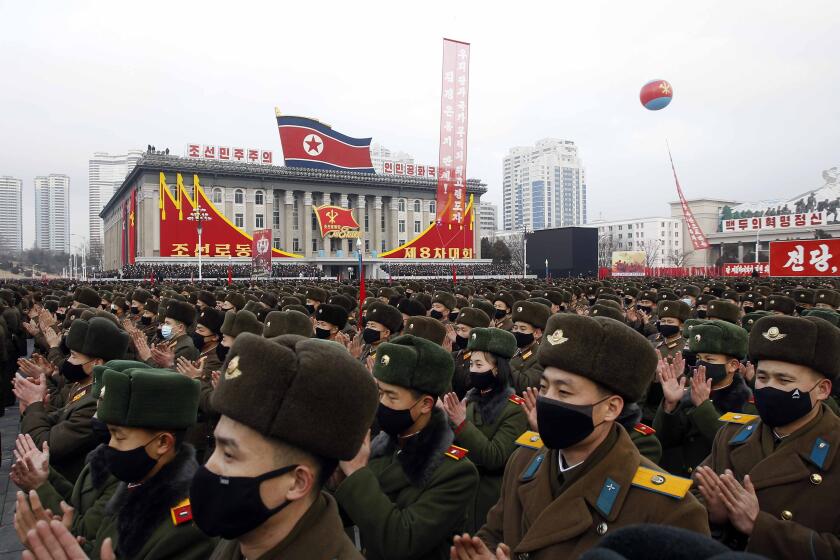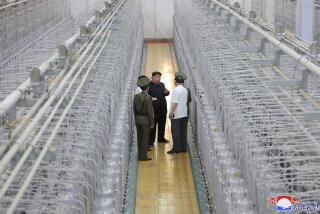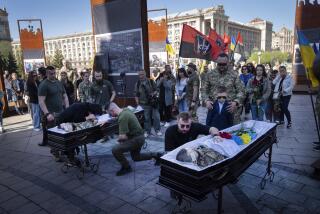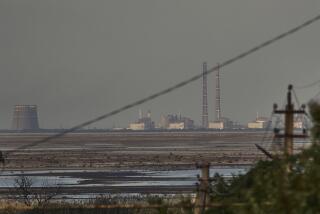Photos show North Korea may be trying to extract plutonium

- Share via
SEOUL — North Korea may be trying to extract plutonium to make more nuclear weapons at its main atomic complex, recent satellite photos indicated, weeks after leader Kim Jong Un vowed to expand his nuclear arsenal.
The 38 North website, which specializes in North Korea studies, cited the imagery as indicating that a coal-fired steam plant at the North’s Yongbyon nuclear complex is in operation after about a two-year hiatus. Smoke was observed emanating from the plant’s smokestack at various times in recent weeks.
This suggests “preparations for spent fuel reprocessing could be underway to extract plutonium needed for North Korea’s nuclear weapon,” the website said Wednesday. But it added that “this could also mean simply the facility is being prepped to handle radioactive waste.”
This week, Rafael Mariano Grossi, the director general of the International Atomic Energy Agency, or IAEA, said some nuclear facilities in North Korea remained in service, citing the operation of the steam plant that serves the radiochemical laboratory at Yongbyon. The laboratory is a facility where plutonium is extracted by reprocessing spent fuel rods removed from reactors.
“The DPRK’s nuclear activities remain a cause for serious concern. The continuation of the DPRK’s nuclear program is a clear violation of relevant U.N. Security Council resolutions and is deeply regrettable,” Grossi told the IAEA’s board of governors, according to the agency’s website. DPRK refers to North Korea’s official name, the Democratic People’s Republic of Korea.
After declaring three years ago that his country had fulfilled its decades-long ambition to become a nuclear power, North Korean leader Kim Jong Un turned his attention to fixing an ailing economy that was undermining his pledge to better the lives of his people.
Plutonium is one of the two key ingredients to build nuclear weapons; the other is highly enriched uranium. The Yongbyon complex, north of the capital city, Pyongyang, has facilities to produce both ingredients. It’s unclear exactly how much weapons-grade plutonium or highly enriched uranium has been produced at Yongbyon, or where North Korea stores it.
Outside estimates on North Korea’s nuclear arsenal vary. In 2018, a South Korean official told parliament that the North may have 20 to 60 bombs.
U.S.-led diplomacy aimed at persuading North Korea to abandon its nuclear program in return for economic and political benefits has been deadlocked since a summit between then-President Trump and Kim collapsed in early 2019. Trump rejected Kim’s calls for extensive sanctions relief in return for dismantling the Yongbyon complex in what was seen as a limited denuclearization step because North Korea had already built nuclear weapons and is believed to be running other covert bomb-making facilities.
In January, Kim vowed to enlarge the country’s nuclear arsenal and disclosed an array of high-tech weapons systems targeting the United States, saying the fate of bilateral ties depends on whether Washington withdraws its hostile policy on North Korea.
Some experts say Kim is attempting to pressure President Biden’s government to return to diplomacy and ease sanctions.
More to Read
Sign up for Essential California
The most important California stories and recommendations in your inbox every morning.
You may occasionally receive promotional content from the Los Angeles Times.














